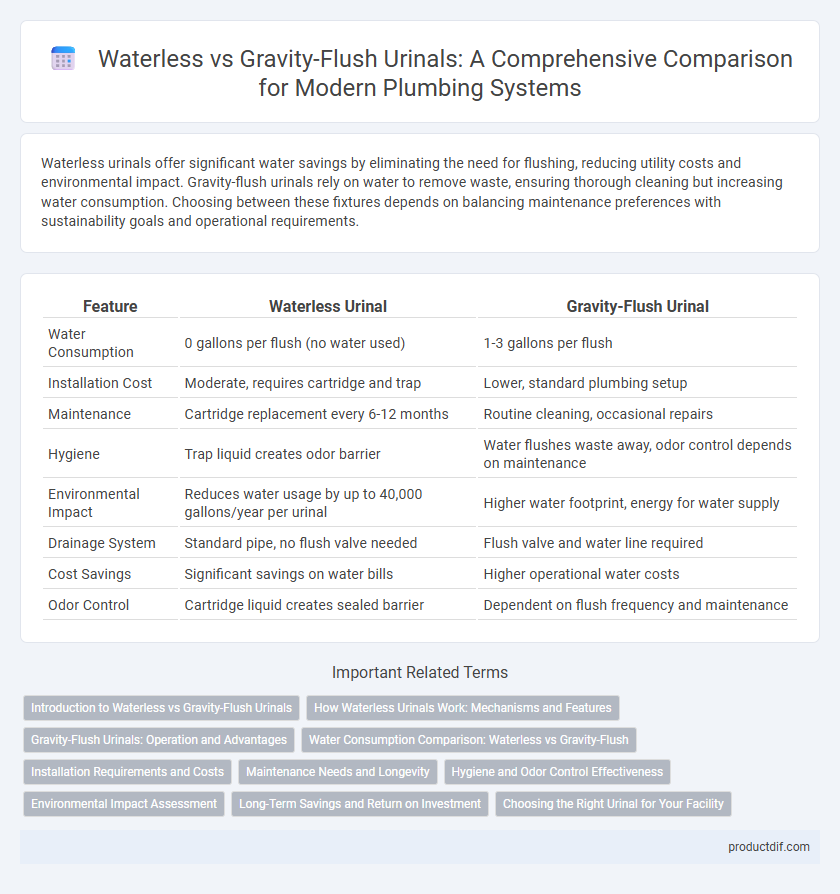Waterless urinals offer significant water savings by eliminating the need for flushing, reducing utility costs and environmental impact. Gravity-flush urinals rely on water to remove waste, ensuring thorough cleaning but increasing water consumption. Choosing between these fixtures depends on balancing maintenance preferences with sustainability goals and operational requirements.
Table of Comparison
| Feature | Waterless Urinal | Gravity-Flush Urinal |
|---|---|---|
| Water Consumption | 0 gallons per flush (no water used) | 1-3 gallons per flush |
| Installation Cost | Moderate, requires cartridge and trap | Lower, standard plumbing setup |
| Maintenance | Cartridge replacement every 6-12 months | Routine cleaning, occasional repairs |
| Hygiene | Trap liquid creates odor barrier | Water flushes waste away, odor control depends on maintenance |
| Environmental Impact | Reduces water usage by up to 40,000 gallons/year per urinal | Higher water footprint, energy for water supply |
| Drainage System | Standard pipe, no flush valve needed | Flush valve and water line required |
| Cost Savings | Significant savings on water bills | Higher operational water costs |
| Odor Control | Cartridge liquid creates sealed barrier | Dependent on flush frequency and maintenance |
Introduction to Waterless vs Gravity-Flush Urinals
Waterless urinals utilize a trap-free design with a sealing liquid that prevents odors while eliminating the need for water during flushing, making them highly water-efficient. Gravity-flush urinals rely on water to flush waste through a trap, which creates a water seal to block sewer gases but consumes significant amounts of water per flush. The choice between waterless and gravity-flush urinals impacts water conservation efforts, maintenance requirements, and overall cost efficiency in commercial plumbing systems.
How Waterless Urinals Work: Mechanisms and Features
Waterless urinals operate using a specialized trap filled with a sealing liquid or mechanical valve that prevents odors from escaping while allowing urine to flow directly into the drainage system. These fixtures eliminate the need for water, relying on gravity and the density difference between urine and the sealing liquid to maintain hygiene and odor control. Advanced waterless urinal designs incorporate antimicrobial coatings and splash guards to optimize cleanliness and reduce maintenance requirements.
Gravity-Flush Urinals: Operation and Advantages
Gravity-flush urinals operate by using water stored in a tank or connected directly to the plumbing system to flush waste through the trap and into the sewer line, ensuring effective flushing with gravity-assisted flow. These urinals provide reliable hygiene by thoroughly rinsing the bowl, minimizing odors and preventing clogging compared to waterless models. The consistent water flow in gravity-flush urinals also maintains sanitation standards and reduces maintenance needs in commercial and public restrooms.
Water Consumption Comparison: Waterless vs Gravity-Flush
Waterless urinals consume zero water per flush, offering up to 100% water savings compared to gravity-flush urinals that typically use 1 to 3 gallons per flush. This significant reduction in water use contributes to lower utility bills and supports sustainable water management in commercial and public facilities. Implementing waterless urinals can result in annual water savings of thousands of gallons depending on facility traffic and frequency of use.
Installation Requirements and Costs
Waterless urinals require simpler installation with no connection to water supply lines, reducing plumbing complexity and saving on water bills. Gravity-flush urinals need standard flush valves, water supply connections, and drainpipes, resulting in higher initial installation costs and ongoing water expenses. The upfront cost of waterless urinals is generally higher due to specialized cartridges, but lower installation and maintenance expenses often lead to long-term savings.
Maintenance Needs and Longevity
Waterless urinals require minimal maintenance with no need for flushing hardware repairs or water supply checks, reducing overall operational costs and simplifying upkeep. Gravity-flush urinals demand more frequent maintenance, including regular flush valve inspections, water line servicing, and potential clog clearing, which can increase labor and parts expenses over time. Longevity of waterless urinals often surpasses gravity-flush models due to fewer mechanical components susceptible to wear and corrosion.
Hygiene and Odor Control Effectiveness
Waterless urinals utilize a specialized trap and sealant liquid to prevent odors while minimizing splash-back, significantly reducing bacterial growth and enhancing hygiene compared to gravity-flush urinals, which rely on periodic water flushing that can leave residual biofilm buildup. Gravity-flush urinals effectively remove waste with each flush, but their reliance on water can sometimes lead to inadequate cleaning in low-flow models, increasing the potential for odor development. In high-traffic areas, waterless urinals provide superior odor control by continuously isolating waste from the user environment, whereas gravity-flush systems require regular maintenance to maintain equivalent hygiene standards.
Environmental Impact Assessment
Waterless urinals drastically reduce water consumption by eliminating the need for flushing, saving an average of 40,000 gallons of water per urinal annually, which significantly lowers wastewater generation and energy associated with water treatment. Gravity-flush urinals consume approximately 1.0 to 1.5 gallons of water per flush, contributing to higher water usage and increased demand on municipal sewage systems, leading to greater environmental strain. Evaluations indicate that waterless systems reduce carbon footprint and resource depletion, making them a more sustainable choice for environmentally conscious plumbing installations.
Long-Term Savings and Return on Investment
Waterless urinals offer substantial long-term savings by eliminating water usage, significantly reducing utility bills and maintenance costs over time. Gravity-flush urinals, while requiring water for each flush, often entail higher operational expenses due to water consumption and potential plumbing repairs. Investing in waterless urinals yields a faster return on investment through lower ongoing costs and enhanced sustainability benefits.
Choosing the Right Urinal for Your Facility
Waterless urinals offer significant water savings by eliminating the need for flushing, making them ideal for facilities aiming to reduce water consumption and environmental impact. Gravity-flush urinals rely on water to effectively remove waste, providing a familiar, low-maintenance option suitable for high-traffic areas where consistent hygiene is critical. Selecting the right urinal depends on factors such as water availability, maintenance capacity, facility usage, and sustainability goals to optimize operational efficiency and cost-effectiveness.
Waterless urinal vs Gravity-flush urinal Infographic

 productdif.com
productdif.com